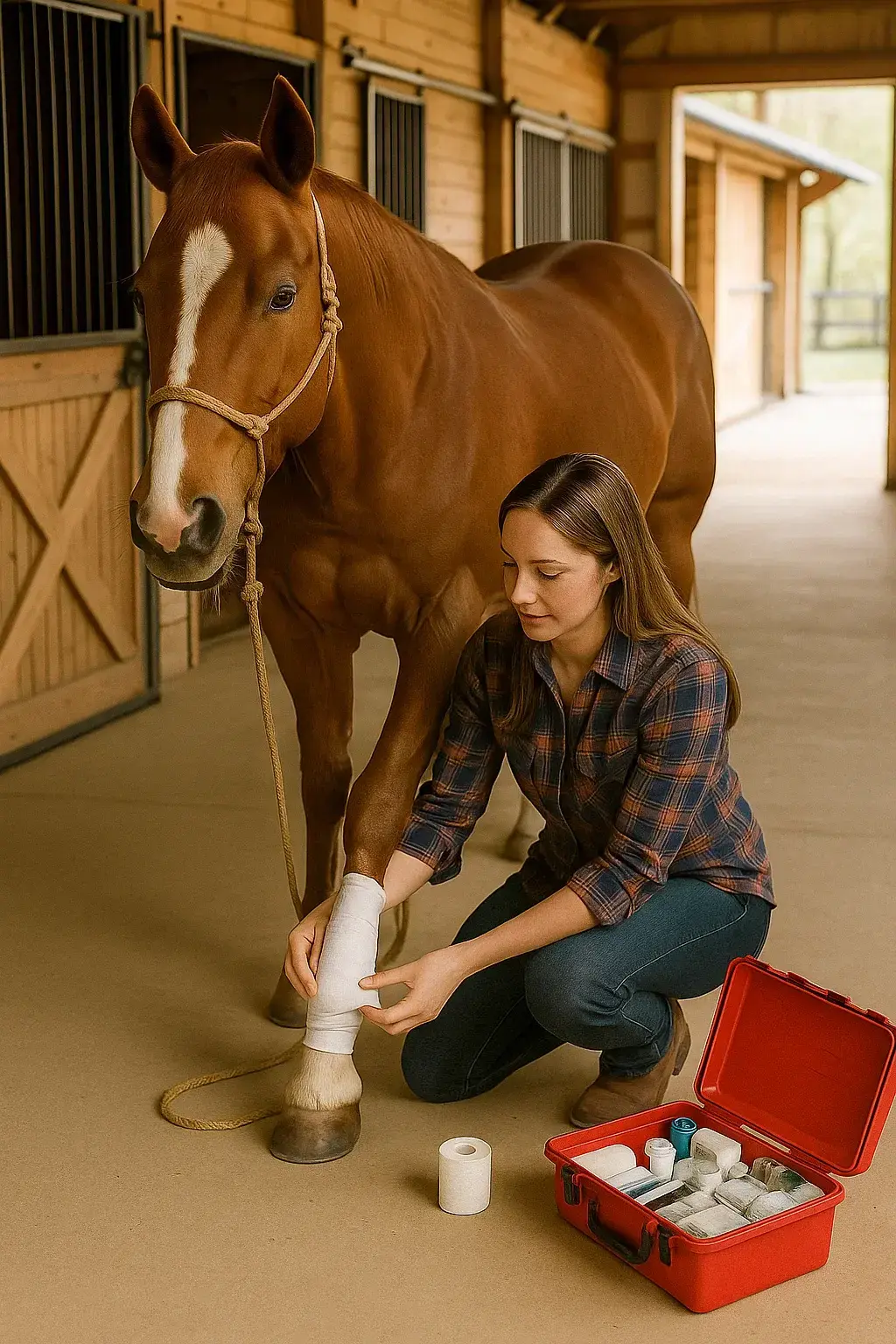
Your Horse’s Lifeline: The First Aid Kit Every Owner Needs
🚑 Barn Emergencies Happen. Will You Be Ready?
You walk into the barn and there it is — a fresh cut staring you in the face. Or worse, your horse steps off the trailer nicked and bleeding. Panic sets in. What now? Injuries are stressful — but scrambling to find supplies makes it worse.
Hi, I’m Sara Bale, your Equine Coach. Today, I’m sharing wisdom passed down from my aunt Jeannie — a nurse and wound-care specialist of 30 years — that changed how I handle horse emergencies: how to build an equine first aid kit that’s practical, affordable, and ready when you need it.
🩹 Why Preparation Matters: Sunny’s Barbed-Wire Lesson
I once turned Sunny (a 10-year-old sorrel Quarter Horse gelding with white socks and a star on his head) and Jack (a 5-year-old sorrel Paint with a bald face) out into the pasture. They were playing by the fence when suddenly, in slow motion, Sunny kicked too close to the barbed wire. His hind leg scraped over the top strand and came back bloody.
My heart pounded at a gallop. But thanks to Jeannie’s advice, I had everything on hand. Within minutes, I rinsed, wrapped, and stabilized his leg. No frantic runs to the feed store, no digging through drawers. Just calm, care, and confidence.
That’s what I want for you. The next time your horse gets hurt — and trust me, it’ll happen — you’ll be ready.
🛒 Build vs. Buy: Which First Aid Kit Works Best?
- Ready-made kits: Online options run $169–$879 and often leave out essentials. If you prefer pre-packed, buy one from your vet, not a generic vet supply store.
- DIY kit: Affordable and customized. With vet guidance, you can put together a kit that truly covers your bases.
- My pick: DIY + a vet-recommended starter kit. Double the security, half the stress.
Note: Some vet-made kits may also include prescription medications like Bute (phenylbutazone) or Banamine paste (flunixin meglumine). These should only be kept and used under the instruction of your vet. A good rule of thumb: if your horse needs more than one dose of pain medication, call your vet.
🎒 Storage & Organization
Forget tiny human first aid kits — horse supplies need space.
- Best options: First responder bag, backpack, or clear plastic tote.
- Pro tip: Keep two kits — one in the barn, one in the trailer.
🧰 Wound Care Arsenal (Must-Haves)
Your horse first aid kit should cover the basics:
- Cleaning & antiseptics: Saline solution for rinsing and Nolvasan (chlorhexidine) for contaminated wounds.
- Protection: Gauze pads, surgical dressings, and non-stick Telfa pads.
- Ointments:
- Neosporin: Topical antibiotic, gentle and safe for small cuts.
- Fura-zone: Stronger topical antibiotic; always wear gloves (carcinogenic in lab animals).
- Wraps & padding: Vet Wrap, cotton or quilted wraps, and plenty of rolls of gauze.
- Tools & extras: Bandage scissors, duct tape, tweezers, nitrile gloves, and specialty items like Animalintex poultice pads, WoundStop bandages, and Elasticon tape.
If your horse got a deep cut right now, could you treat it without running to the feed store? If you’re not 100% sure, you’ll want to see my full equine first aid checklist — I’ll link it at the end of this post.
❤️ Vitals Monitoring
Know your horse’s “normal” before you need it. For one week, practice taking vitals once a day while you and your horse are calm. Write them down to build a baseline. That way, you and your vet can spot trouble fast.
- Heart rate: 28–55 beats/min at rest (stethoscope behind the left elbow, or pulse under the jaw).
- Respiration: 8–16 breaths/min at rest (watch the flank rise/fall).
- Temperature: 99.0–101.5°F (lubricated rectal thermometer).
- Capillary refill time (CRT): Press the pink gum above the incisors for 2 sec, then release. Normal is 1–2 sec.
- Slower = possible dehydration, shock, poor circulation.
- Very fast with dark red gums = possible toxicity or heat stress.
- Gum color: Pale/white = shock or anemia, blue/purple = low oxygen, yellow = jaundice.
Keep a vitals log — write them down in a notes app or a notebook, and store a copy in your first aid kit.
📞 Call the Vet: What to Share
Before an emergency, establish a relationship with a vet who knows your horse. This makes a huge difference — they’ll already understand your horse’s history and can prioritize your case quickly.
When you call, be ready to share:
- Be succinct — as few words as possible.
- Is your horse standing or lying down?
- Vitals: temperature, heart rate, and capillary refill time (CRT). Exception: skip vitals in cases of severe cuts or trauma since stress alone will elevate them.
- Breed, age, mare/gelding/stud.
- Severity of illness or injury and location (example: there’s a deep laceration on her left front leg, she’s reluctant to bear weight on it).
- Useful history: Is it a new issue or an ongoing one? Example: I took Diamond to the vet, she received an injection in her hock, and now she’s lame.
- Include what you’ve done (example: I cleaned the wound, dressed it, and called you).
- For colic: Is your horse eating and drinking? When was the last poop, and what was the consistency?
- For wounds: How much bleeding? Any bone or tendon visible? Are they weight-bearing?
- Photos — vets can triage much faster with visuals.
🌟 Final Thoughts
Before an emergency, establish a relationship with a vet who knows your horse. This makes a huge difference — they’ll already understand your horse’s history and can prioritize your case quickly.
Special thanks to Heidi Lescun, Anesthesiologist, and Jill Clark, DVM for their medical insights that inspired this guide.
Don’t wait for a midnight emergency. Take one hour this week to build (or upgrade) your kit. Want my printable Equine First Aid Checklist? Email me at sara@equinecoachsara.com and I’ll share it with you.
Pilots, vets, doctors, and nursing staff all have laminated cards with step-by-step directions to follow during a crisis. I will be building crisis cards with DVM Jill Clark for you with step-by-step directions to help you during equine emergencies. You can keep these crisis cards in your vet bags to help you feel safe, calm, and prepared.
Colic is one of the most preventable — yet feared — emergencies in horses. In my next blog, I’ll show you simple steps to lower your horse’s risk and catch the warning signs early.
💼 How I Can Help You Beyond First Aid
Along with teaching horse care, I specialize in professional training barrel racing, western riding, trail riding, and behavior solutions. I also design customized riding lessons to fit each rider’s goals — whether you’re building confidence on the trail, polishing your arena skills, or aiming for the next level in competition.
❓ Your Turn!
What horse care or training topics would you like me to cover next? Email me at sara@equinecoachsara.com. I’d love to hear your questions and shape future posts around what matters most to you and your horse.
